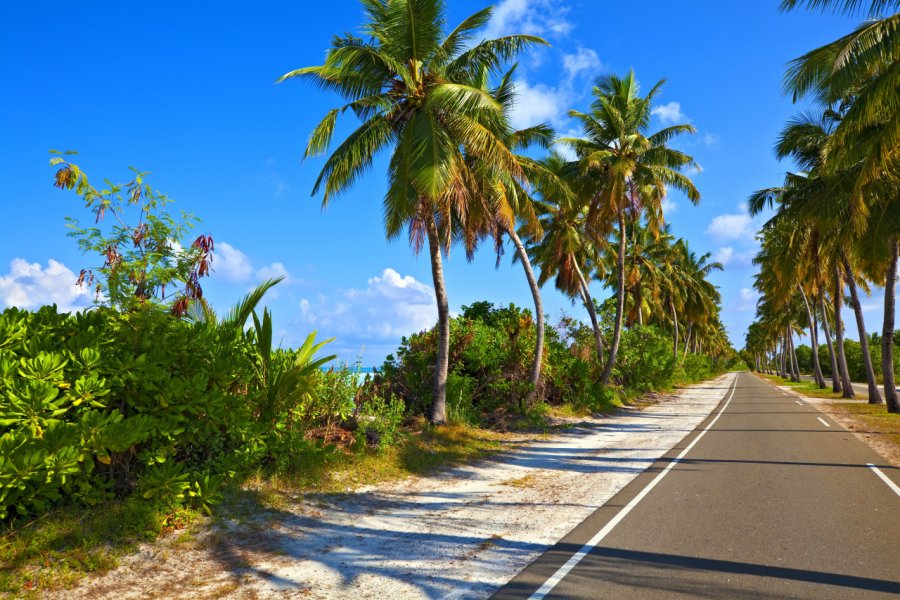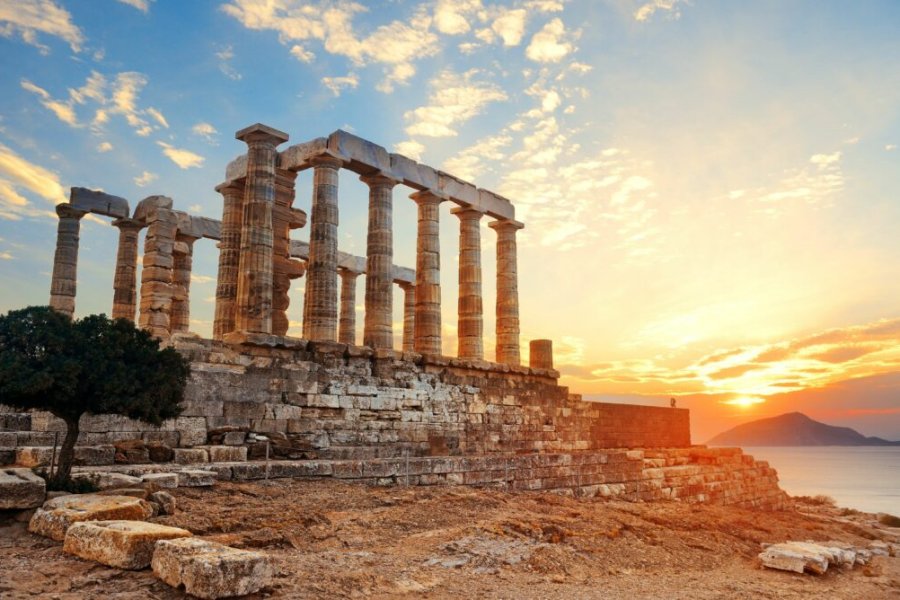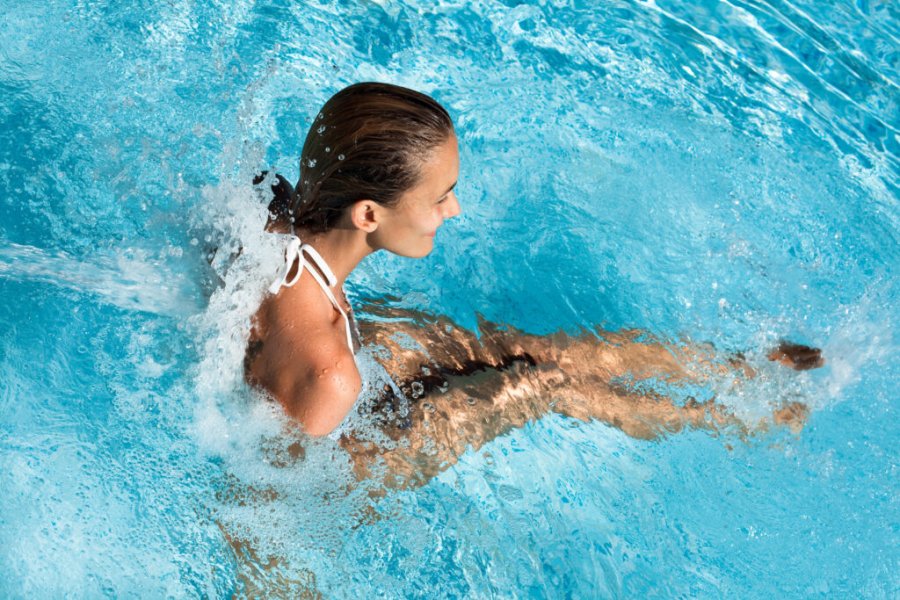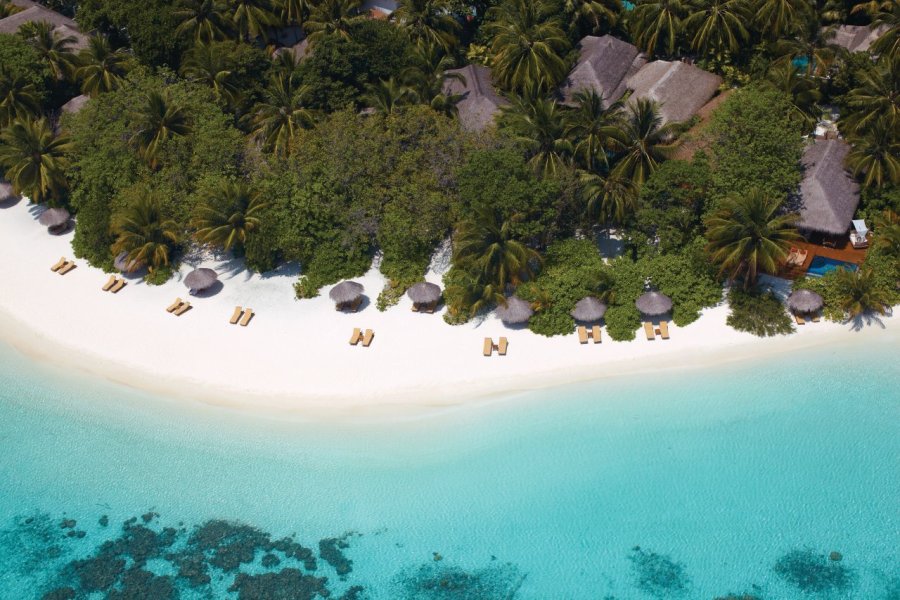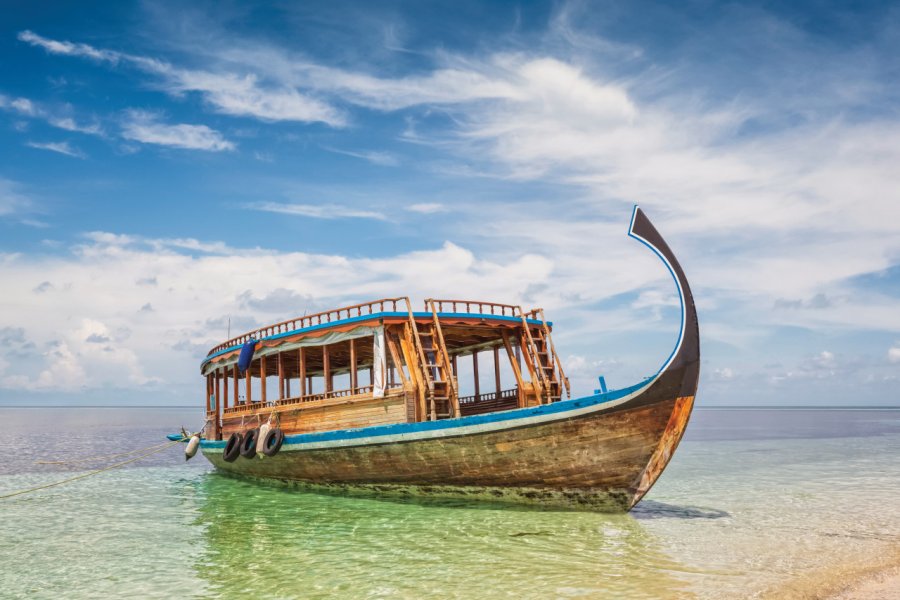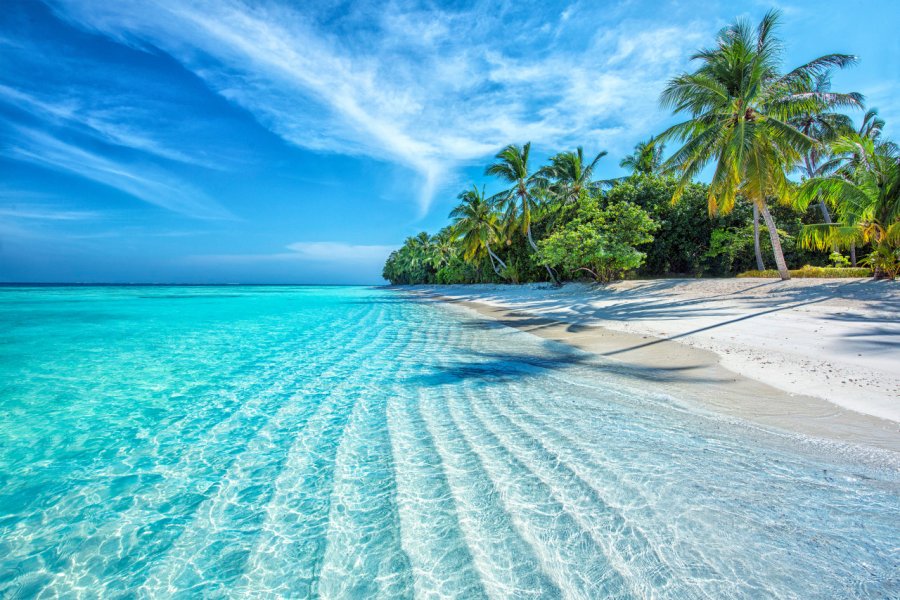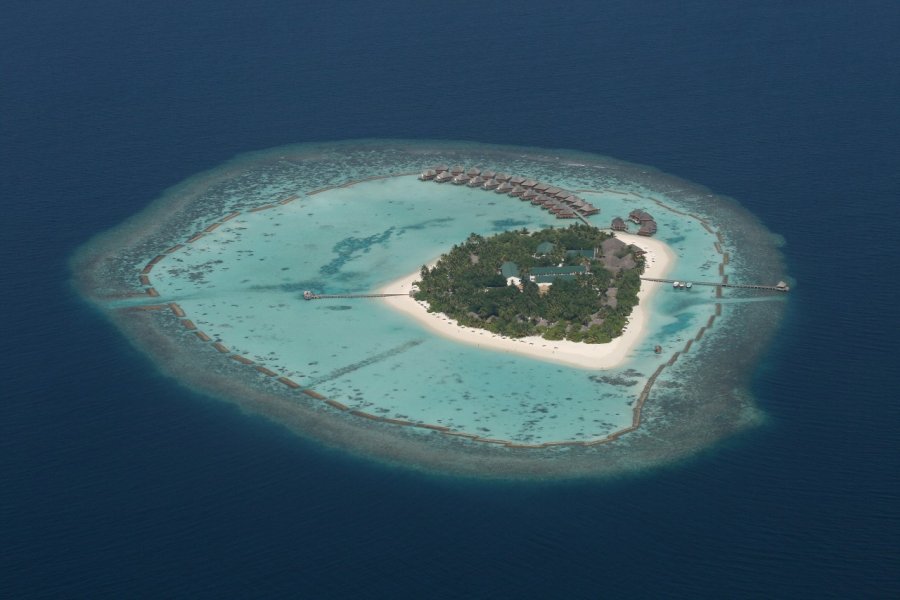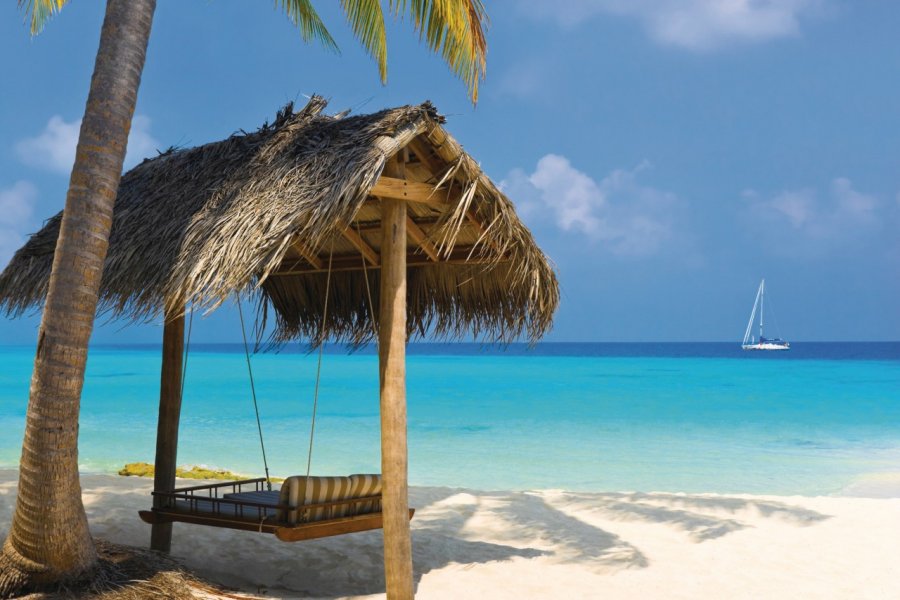Travel guide Maldives
A tropical country in the Indian Ocean, the Maldives is made up of 26 ring-shaped atolls with over 1,000 coral islands. You reach your island-hotel from Malé, the capital, by seaplane and that's it! The flight over the atolls will remain a great moment of your stay in the Maldives. The seaplane lands on the lagoon and you board a dhoni, a small traditional fishing boat, to reach the shore of your island by sailing on turquoise water... great class! In the Maldives, the hotels with their villas on stilts compete in luxury and do everything to make you feel in paradise. Atolls and beaches, bungalows and coconut trees, fresh fish and fruit every day, massages and cruises... Sportsmen will go fishing on a dhoni, play beach volleyball, canoe on the coral reef, windsurf or catamaran, dive or surf. Don't miss a stopover in Malé, where you will enjoy the fish market and Majeedhee Magu, the main road, which you will follow to haggle in the small handicraft stores before sitting down in a traditional restaurant. You will be amazed by the mosque of Hukuru Miskiy all carved white coral (17th century). And already, it will be time to return to your palms or your hammocks. A look at your tour guide to learn more about the history of the Maldives, perhaps?
What to see, what to do Maldives?
-
Book an activity
-
Customized travel
- The most beautiful cities Maldives
When to go Maldives ?
The high tourist season includes the dry period from December to April. From May to October, it is the monsoon season, and therefore the one with the lowest tourist numbers. The sea is agitated by the winds, but the days of non-stop rain are very rare and the weather remains of course very sunny. The months to be avoided are June and July, during which rains can be more frequent. But of course, this is when the Maldives is within reach of the most modest pockets.
Hotel prices are particularly high between the holidays in late December and mid-January, and at Easter. The months of January, February and March provide maximum sunshine. If you have a very tight budget and you are dreaming of the Maldives, consider a departure in May or June. Because if the monsoon brings some rain, it is very rare to experience full days of rain.
Suggested addresses Maldives
Travel Maldives
-
Find a hotel
-
Car Rental
-
International e-SIM package
-
Find a local agency
On vient surtout aux Maldives pour se reposer dans un cadre idyllique tout en profitant d'un climat clément et des joies de la vie marine. Les plus curieux tenteront d'allier la visite d'une ou deux îles locales à leur séjour sur une île-hôtel. Cela leur permettra d'aller à la rencontre des Maldiviens et de s'apercevoir que ce sont des gens charmants et chaleureux. Une visite de Malé, la plus petite capitale du monde peut également s'avérer intéressante. Il y a peu de choses à voir, mais là encore, cela permet de mieux appréhender la culture maldivienne et de s'initier pourquoi pas à la cuisine locale. En raison de tarifs élevés, les Maldives ne sont pas à la portée de toutes les bourses. C'est la raison pour laquelle, de nombreux touristes se rendant au Sri Lanka, profitent de la proximité, pour s'offrir deux ou trois nuits sur une île maldivienne paradisiaque ou sur une île locale aux tarifs bien plus doux.
Find unique Stay Offers with our Partners
How to go Maldives
How to go alone
To leave alone your trip to the Maldives is possible but expensive, even very expensive. You must contact the company that serves the island of your choice, but the prices of the flights, not negotiated, are very high. Try to negotiate through your hotel. Tight budgets will choose the local islands and guest-houses where the rates remain reasonable and the ferry trips are very cheap.
How to go on a tour
For a stay in the Maldives, it is highly recommended to go through a tour operator from your home country, which will offer you a package including the ticket, transfers and full board in an island-hotel for one, two weeks or even more, at interesting prices if not affordable. But everything is perfectly organized and you can go with peace of mind.
How to get around
No public transportation between resorts in the Maldives. Inter-island transfers are on demand. To go from one island to another, you will have to go back to Malé airport. There are five options: seaplane, domestic flight, ferry - if the island is close enough to Malé -, speed boat and dhoni. Depending on the distance of the island from the capital Malé and the presence or not of an airport (domestic flight) or a resort (seaplane) in the vicinity, your guest-house will indicate you the options and associated prices.
Featured articles Maldives
Discover Maldives
While the dazzling white beaches and multi-hued blue waters attract tourists in droves, it would be a shame to miss out on Maldivian culture. You can get a quick overview by spending half a day in Malé or a few hours on a local island close to your island-hotel. You'll get a much better idea if you choose to stay on the inhabited islands, and you'll soon realize that Maldivians love nothing more than to share their culture. Our pages offer you the chance to immerse yourself in the culture of the islanders, whose only source of income for many years was fishing. You'll learn that, before becoming an Islamic republic, the Maldives were at the crossroads of numerous maritime routes between Africa and South Asia, the Middle East and Southeast Asia, creating a crossbreeding that continues even in the cuisine and certain folk customs.
Pictures and images Maldives
The 12 keywords Maldives
1. Atoll

An atoll is an island consisting of a barrier reef, one or more sandy islands surrounding a central depression. The Maldives has a total of 26 atolls of various shapes and sizes, most of which are made up of numerous islands. The best way to get a feel for the islands is to take a flight over the archipelago by plane or seaplane.
2. Coconut tree

The coconut tree would have invested the Maldives archipelago pushed by the sea. Or more exactly, its fruit would have failed on an island, would have germinated to give a tree. The islanders knew how to exploit it fully. The nuts provide water, food and are transformed into ropes. The palms become roofs or partitions once braided.
3. Coral
The sumptuous coral reefs have made the Maldives one of the best diving destinations. Unfortunately, ocean warming has led to coral bleaching and death throughout the archipelago. Specialized NGOs are trying to fight against the disappearance of corals by creating nurseries of regrowth.
4. Dhoni

The traditional Maldivian boat is recognizable by its curved bow. Formerly powered by a lateen sail, it is now equipped with a motor and is used for short distance and long distance sea trips. It is the fishing boat par excellence, but it is also fitted out for diving and some resorts have made them into romantic boats.
5. Gulha
Gulhas are one of the Maldivian snacks not to be missed. You will find them in cafes on the local islands and sometimes at the island-hotel buffets. It is a fried dumpling stuffed with tuna, finely chopped onion, grated coconut and chilli. These snacks are eaten at any time and Maldivians love them.
6. Seaplane
As soon as you move away from Male, the island hotels are served by seaplanes. If the ticket is expensive, the experience is well worth the detour. The ocean is adorned with turquoise and white polka dots, drawn by the lagoons and islands. For good photos, make sure you get on board first and take a seat behind the cockpit.
7. Islands
With its 1,200 islands, the Maldives is one of the largest archipelagos in the world. Most of them are mere confetti topped with a few coconut trees. Surrounded by turquoise lagoons, wrapped in white sand, the Maldivian islands are the perfect postcard of the dream island, the ones that forged the legend of Robinson Crusoe.
8. Miskiiy
Miskiiy means "mosque" in Divehi, the local language. There are some ancient buildings in the country, especially in Male, which are worth a visit. Traditionally, mosques were built of coral blocks, then topped with a roof of woven palm fronds. Corrugated iron has replaced the fringes, but the mosques have retained their charm.
9. Stingray
Many experienced divers choose to come to the Maldives to rub shoulders with the magnificent manta rays. Depending on the season and location, they are very easy to spot. They cruise Maldivian waters feeding on plankton. Very common around Hanifaru Bay, up to 50 can be seen in one dive.
10. Shark
The shark is the reputation of Maldivian waters, most often in its most harmless species. You can swim in peace with reef sharks, nurse sharks or whale sharks, the largest fish in the world! But if you're lucky you might see the hammerhead or tiger shark.
11. "Sunset"

In addition to its paradisiacal beaches and crystal clear waters, the country is renowned for its sumptuous sunsets. The island-hotels seem to be inspired by this to offer a number of activities: yoga, dolphin cruises, traditional fishing trips... It's no coincidence that villas overlooking the sunset are rented at a higher rate.
12. Yellowfin tuna
The yellowfin tuna fishery has long been the country's most important source of income. The waters are teeming with this silvery fish with yellow fins. Fishing is still a major economic activity in the country. Tuna is the staple food of the Maldivian, which he loves in all its forms: grilled, stewed or dried.
You are from here, if...
You eat with your right hand, the left being reserved for functions considered impure. This only applies on local islands or if you're a guest. On island hotels, you are entitled to cutlery.
You remove your shoes before entering a house or store. This is compulsory at the entrance to mosques.
You must dress decently in all circumstances. This means wearing pants for men and covering clothing for women, even in the sea. Veils, however, are not compulsory.
Take your time and keep your cool. The tropical climate means you'll have to take it easy, at a gentle pace.
You don't touch coral or fish during your dives. The Maldivians are fighting to protect their seabed, and preservation means respecting the environment.

